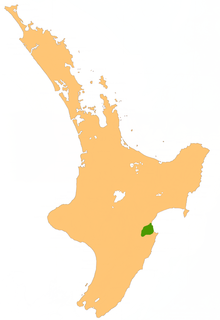Hawke's Bay is a local government region on the east coast of New Zealand's North Island. The region's name derives from Hawke Bay, which was named by Captain James Cook in honour of Admiral Edward Hawke. The region is governed by Hawke's Bay Regional Council.

Napier is a city on the eastern coast of the North Island of New Zealand and the seat of the Hawke's Bay region. It is a beachside city with a seaport, known for its sunny climate, esplanade lined with Norfolk Pines and extensive Art Deco architecture. Napier is sometimes referred to as the "Nice of the Pacific".

Hastings is an inland city of New Zealand and is one of the two major urban areas in Hawke's Bay, on the east coast of the North Island. The population of Hastings is 50,100, with a further 15,150 people in Havelock North and 2,460 in Clive. Hastings is about 18 kilometres inland of the coastal city of Napier. These two neighbouring cities are often called "The Bay Cities" or "The Twin Cities".

Havelock North is a town in the Hawke's Bay region of the North Island of New Zealand, situated less than 2 km south-east of the city of Hastings. It was a borough for many years until the 1989 reorganisation of local government saw it merged into the new Hastings District, and it is now administered by the Hastings District Council.

The Heretaunga Plains is a 300 square kilometres (120 sq mi) alluvial plain at the southern end of Hawke Bay on the east coast of the North Island of New Zealand. The towns of Napier, Hastings and Havelock North are on the plain.

Statistics New Zealand defines urban areas of New Zealand for statistical purposes. The urban areas comprise cities, towns and other conurbations of a thousand people or more. In combination, the urban areas of the country constitute New Zealand's urban population. As of June 2018, the urban population made up 88.7% of New Zealand's total population.

Hastings District is a territorial authority district within the Hawke's Bay Region, on the east coast of the North Island of New Zealand. It covers the southern half of the Hawke's Bay coast, excluding Napier City, which is a separate territorial authority. Hastings District Council is headquartered in the city of Hastings, the district's largest town.
Taradale is a suburb of the City of Napier, in the Hawke's Bay Region of the North Island of New Zealand. It is a predominantly middle-upper class residential suburb, located 10 kilometres southwest of the centre of Napier. The Taradale ward, which includes Greenmeadows, Meeanee, and Poraiti, had a population of 22,809 in the 2018 New Zealand census.

Heretaunga Street is the main arterial road through Hastings City in New Zealand running from north-west to south-east.

State Highway 2 runs north–south through eastern parts of the North Island of New Zealand from the outskirts of Auckland to Wellington. It runs through Tauranga, Gisborne, Napier, Hastings and Masterton. It is the second-longest highway in the North Island, after State Highway 1, which runs the length of both of the country's main islands.
The Hawke's Bay Expressway, known also as the Napier-Hastings Expressway, runs from Hawke's Bay Airport, through Napier and Hastings, and ends at Pakipaki, just south of Hastings, a total length of 24 km.
Te Awanga is a small rural beachside town in Hawke's Bay, New Zealand. Te Awanga is near Cape Kidnappers, which has a renowned colony of the Australasian gannet.
Rugby League Hawkes Bay is the local sporting body responsible for the administration of rugby league in the Hawke's Bay region of New Zealand. The RLHB run the local club competition and are responsible for the Hawke's Bay rugby league team. They are part of the New Zealand Rugby League's Mid-Central Zone and their players are eligible for the Central Vipers.
Eskdale is a rural settlement in the Hastings District and Hawke's Bay Region of New Zealand's North Island. It is located north of Napier on State Highway 5, near the mouth of the Esk River.
Pakipaki is a pā kāinga village and rural community in the Hastings District and Hawke's Bay Region of New Zealand's North Island. The village is home to many Ngāti Whatuiāpiti hapū tribes represented by their three marae of Houngarea, Mihiroa, and Taraia. The village is also the home of the Hawke's Bay Catholic Māori Mission and displays the Foundation Stone for the Catholic Church in Hawke's Bay. Pakipaki is a Sacred Space in the Footsteps of Venerable Suzanne Aubert.
Pakowhai is a small settlement in the Hastings District and Hawke's Bay Region of New Zealand's North Island. It is a located between Napier and Hastings, north of the Ngaruroro River.
State Highway 51 is a New Zealand state highway that runs between Napier and Hastings via Clive. Known locally as the Coastal Route, it was the main route between the two cities prior to the completion of the Hawke's Bay Expressway.
Hastings District Council is the territorial authority for the Hastings District of New Zealand.
Napier City Council is the territorial authority of Napier, Hawke's Bay Region, New Zealand.









